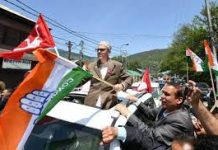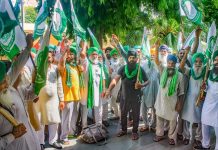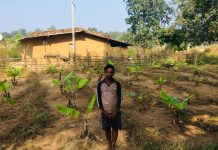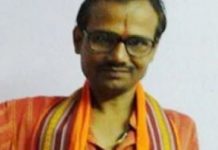 Derived from Atharva Veda which contained details about early understanding of human body, its diseases and their cures, is a healing method that relies on herbs as medicines for maintaining good health. The herbs recommended for treatment were numerous. The golden age of Indian medicine was marked especially by the production of the medical treatises known as the Charaka-samhita and Sushruta-samhita, attributed respectively to Charaka, a physician, and Sushruta, a surgeon. Vagbhatta’s Astangahrdaya dated the seventh century CE is another important text of Ayurveda. References to Ayurveda are also found in epics, Jatakas, travel accounts, and other literature dating to early centuries of Christian era.
Derived from Atharva Veda which contained details about early understanding of human body, its diseases and their cures, is a healing method that relies on herbs as medicines for maintaining good health. The herbs recommended for treatment were numerous. The golden age of Indian medicine was marked especially by the production of the medical treatises known as the Charaka-samhita and Sushruta-samhita, attributed respectively to Charaka, a physician, and Sushruta, a surgeon. Vagbhatta’s Astangahrdaya dated the seventh century CE is another important text of Ayurveda. References to Ayurveda are also found in epics, Jatakas, travel accounts, and other literature dating to early centuries of Christian era. The Charaka Samhita expounded the foundational ideas of logic so that diagnosis and treatment could be based on valid observations and reasoning. Its therapeutics consisted of both purificatory and curative methods. Purification, both internal and external, is achieved through a systematic procedure of panchakarma (five processes). Curative methods involve various means and measures to restore the balance of the vitiated dosas. Diseases could also be caused by the derangement of phlegm, wind, or bile, due to seasonal changes, infection with germs or worms, and due to contaminated or unwholesome food. Certain symptoms such as fever are classified in fair detail, and it is recognized that fever is the “sister” or “cousin” of other diseases. Hereditary diseases were also known.
The Charaka Samhita expounded the foundational ideas of logic so that diagnosis and treatment could be based on valid observations and reasoning. Its therapeutics consisted of both purificatory and curative methods. Purification, both internal and external, is achieved through a systematic procedure of panchakarma (five processes). Curative methods involve various means and measures to restore the balance of the vitiated dosas. Diseases could also be caused by the derangement of phlegm, wind, or bile, due to seasonal changes, infection with germs or worms, and due to contaminated or unwholesome food. Certain symptoms such as fever are classified in fair detail, and it is recognized that fever is the “sister” or “cousin” of other diseases. Hereditary diseases were also known. According to the compendium of Charaka, the Charakasamhitā, health and disease are not predetermined and life may be prolonged by human effort. The compendium of Suśruta, the Suśrutasamhitā defines the purpose of medicine to cure the diseases of the sick, protect the healthy, and to prolong life. Both these ancient compendia include details of the examination, diagnosis, treatment, and prognosis of numerous ailments. The Suśrutasamhitā is notable for describing procedures on various forms of surgery, including rhinoplasty, the repair of torn ear lobes, perineal lithotomy, cataract surgery, and several other excisions and other surgical procedures. Most remarkable is Sushruta’s penchant for scientific classification: His medical treatise consists of 184 chapters, 1,120 conditions are listed, including injuries and illnesses relating to aging and mental illness. The Sushruta Samhita describe 125 surgical instrument, 300 surgical procedures and classifies human surgery in 8 categories.
According to the compendium of Charaka, the Charakasamhitā, health and disease are not predetermined and life may be prolonged by human effort. The compendium of Suśruta, the Suśrutasamhitā defines the purpose of medicine to cure the diseases of the sick, protect the healthy, and to prolong life. Both these ancient compendia include details of the examination, diagnosis, treatment, and prognosis of numerous ailments. The Suśrutasamhitā is notable for describing procedures on various forms of surgery, including rhinoplasty, the repair of torn ear lobes, perineal lithotomy, cataract surgery, and several other excisions and other surgical procedures. Most remarkable is Sushruta’s penchant for scientific classification: His medical treatise consists of 184 chapters, 1,120 conditions are listed, including injuries and illnesses relating to aging and mental illness. The Sushruta Samhita describe 125 surgical instrument, 300 surgical procedures and classifies human surgery in 8 categories.Shushruta specialised in ophthalmic surgery (extraction of Cataracts). Shushruta was one of the first to study the human anatomy. In the Shusruta Samahita he has described in detail the study of anatomy with the aid of a dead body. Shusruta’s forte was rhinoplasty (Plastic surgery) and ophthalmialogy (ejection of cataracts). Shushruta has described surgery under eight heads Chedya (excision), Lekhya (scarification), Vedhya (puncturing), Esya (exploration), Ahrya (extraction), Vsraya (evacuation) and Sivya (Suturing). The practice of surgery has been recorded in India around 800 B.C. This need not come as a surprise because surgery (Shastrakarma) is one of the eight branches of Ayurveda the ancient Indian system of medicine.
 The Ayurvedic practitioner was called vaidya, meaning a person of profound knowledge, who made use of what is called rational therapy. He examined the individual as a whole and not just his disease, took a careful note of the patient’s innate physiology, mental state, and other factors such as age, food habits, and season of occurrence of disease. The vaidya conducted a thorough examination using both direct perception (pratyaksha) and inference (anumana). In addition, oral or written testimony of the personal experience of Ayurvedic experts was also accepted as a diagnostic tool (aptopadesha). The vaidya was also expected to question the patient in great detail (prashna), conduct a thorough physical examination using all his five senses (panchendriya pariksha), and confirm or negate his diagnosis through experimentation (yukti). Laying much emphasis on the vaidya’s knowledge of drugs, he was supposed to keep in mind both its therapeutic and adverse effects. The Vaidyas laid equal emphasis on the cure of disease as well as prevention and health promotion. They prescribed a daily and seasonal routine as well as attention to nutrition for maintenance of a balanced state of health.
The Ayurvedic practitioner was called vaidya, meaning a person of profound knowledge, who made use of what is called rational therapy. He examined the individual as a whole and not just his disease, took a careful note of the patient’s innate physiology, mental state, and other factors such as age, food habits, and season of occurrence of disease. The vaidya conducted a thorough examination using both direct perception (pratyaksha) and inference (anumana). In addition, oral or written testimony of the personal experience of Ayurvedic experts was also accepted as a diagnostic tool (aptopadesha). The vaidya was also expected to question the patient in great detail (prashna), conduct a thorough physical examination using all his five senses (panchendriya pariksha), and confirm or negate his diagnosis through experimentation (yukti). Laying much emphasis on the vaidya’s knowledge of drugs, he was supposed to keep in mind both its therapeutic and adverse effects. The Vaidyas laid equal emphasis on the cure of disease as well as prevention and health promotion. They prescribed a daily and seasonal routine as well as attention to nutrition for maintenance of a balanced state of health.
Ayurvedic preceptors conceived the role of a physician as much more than mere treatment of diseases. He was to help an individual reach the ultimate spiritual goal of self-emancipation, which would not be possible without a healthy mind and body. He was to educate the people about health and disease, and be able to communicate with the lay public and the scholars alike. This required wisdom and skilled communication. Charaka says this about the goal of the vaidya, “Not for self, not for the fulfillment of any earthly desire or gain, but solely for the good of suffering, should you treat your patients and so excel all. Those who sell the treatment of diseases as merchandise gather dust and neglect gold.” The ancient texts talk in detail about the doctor-patient relationship. A vaidya was expected to be friendly and sympathetic toward his patients so that they do not fear him. Charaka recommends that the vaidya keep his conclusions to himself to avoid potential harm. Ayurvedic texts prohibit physicians from private conversations or indulging in jest with women.
A vaidya was expected to be proficient in all fields of medicine including surgery. There is evidence to show that vaidyas were well paid. There were many checks on the vaidyas. License from the state was a prerequisite for taking up medical practice. Fines were imposed for the incorrect treatment of patients. Yet, the vaidya had a lot of autonomy as the law codes advise not to argue with physicians. Sushruta Samhita prescribes the dress code of white or brownish yellow clothes for the vaidya. Vaidyas resorted to spiritual therapy for diseases whose cause were unknown. Psychic therapy was applied to diseases of the mind. The vaidya prescribed various methods at his discretion, to keep the mind away from harmful thoughts. Medicine for the vaidyas was a fulltime profession. There were individual practitioners, vaidyas attached to hospitals, and vaidyas employed by the state. Physicians in state service had to attend to the royal family, courtiers, and palace retinue. The highest position among these state physicians was occupied by the king’s personal vaidya known as the Raja-Vaidya.
and holistic.












